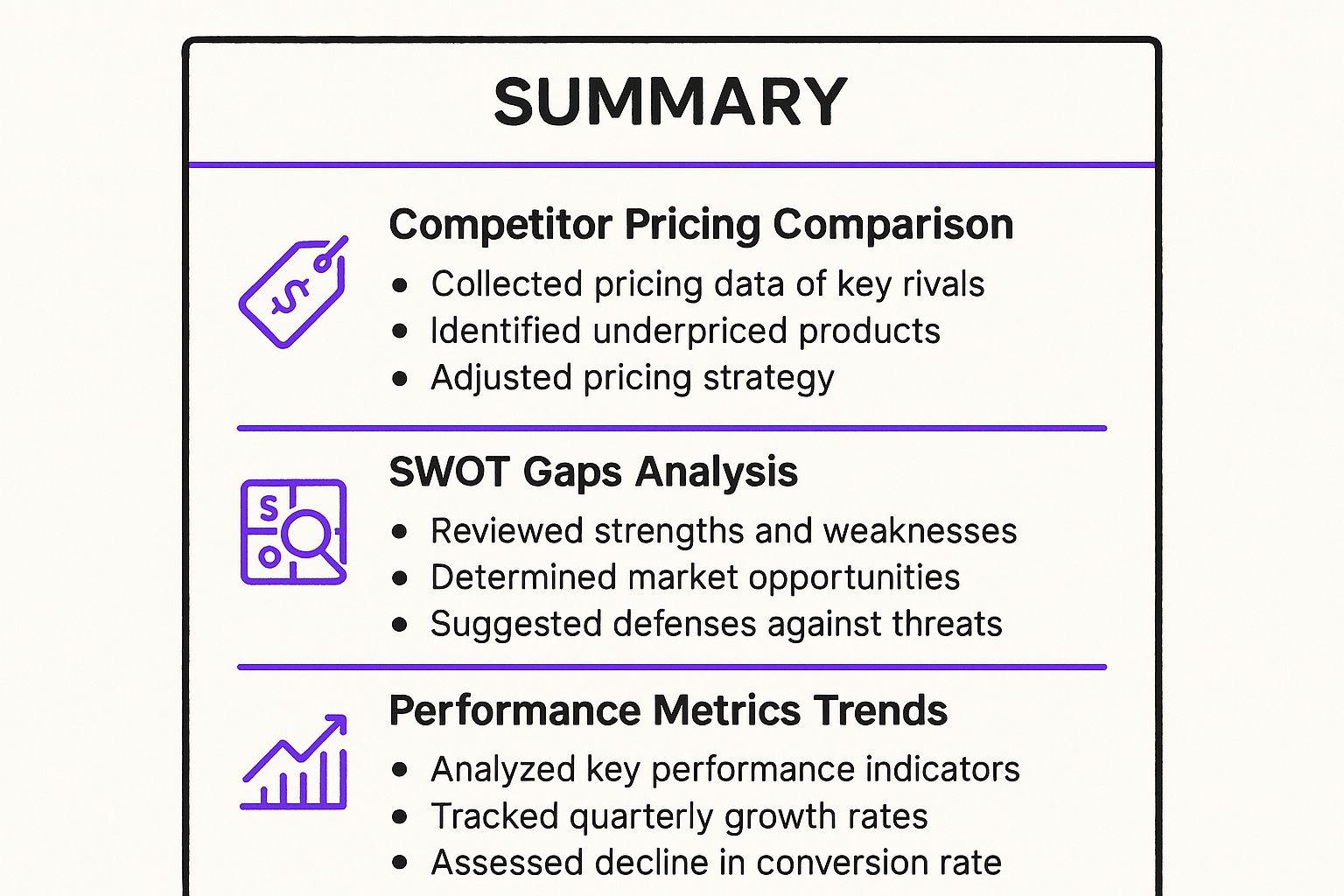10 Competition Marketing Strategies to Win in 2025
Uncover 10 battle-tested competition marketing strategies. Learn how to analyze rivals, differentiate your brand, and dominate your market this year.

Look, you've built something awesome. The problem? So has the company next door. In a crowded market, just "being good" won't cut it. You need to be smarter, faster, and maybe a little sneakier. That's where solid competition marketing strategies come in. This isn't about shady corporate espionage; it's about knowing the battlefield so you can outplay everyone and claim your turf.
Forget the boring, obvious advice you've read a thousand times. We’re diving into 10 practical strategies you can actually use to stop playing defense and start scoring big. From spying on your rivals (legally, of course) to becoming a challenger brand that punches way above its weight, we've got you covered. To really steal your competitors' playbook, consider specific industry examples, such as leveraging SEO for restaurants to outperform online competition.
This guide will show you how to analyze your rivals' every move, find the gaps they've missed, and create a game plan to win. Ready to turn the tables? Let's get to it.
1. Competitive Benchmarking: Know Where You Stand (and Where to Strike)
Okay, let's start with the basics, but with a twist. Competitive benchmarking isn't about making massive, boring spreadsheets that no one reads. Think of yourself as a detective. Your mission is to figure out exactly what your rivals are doing better, worse, or just plain weird.
This is the foundation for any sharp competition marketing strategy. It's like getting a cheat sheet for your industry by comparing things like pricing, product features, and even how much people complain about them on social media. This process reveals golden opportunities to level up your own game and find gaps you can drive a truck through.
For example, Samsung famously benchmarked Apple's retail experience to make its own stores less soul-crushing, and Pepsi is always watching Coca-Cola’s every move to find an edge. It’s a proven way to turn spying into strategy.
How to Implement Competitive Benchmarking
Getting started is easier than you think. Just focus on what actually matters to your customers.
- Pick Your Rivals Wisely: Choose 3-5 competitors. Grab your arch-nemesis, a scrappy startup, and an industry giant. This gives you a full 360-degree view.
- Focus on What Sways People: Don't track everything. Zero in on stuff that makes a customer choose them over you, like pricing tiers, unique features, or customer support that doesn't make you want to scream.
- Gather Your Intel: Use a mix of sources. Check customer review sites, do some mystery shopping, and use tools to analyze their digital footprint. Tools like Ahrefs or Semrush are powerful, but they can be expensive. For deep technical and content analysis, a great alternative is already.dev.
This summary box highlights the essential areas to focus on when analyzing competitors.

This kind of analysis helps you pinpoint exactly where a competitor's pricing is a joke or where your product's strengths can win over their unhappy customers.
2. Differentiation Strategy: Stand Out or Get Lost in the Crowd
Let's be real: competing on price alone is a race to the bottom where everyone loses. A differentiation strategy is your way of saying, "We're not just another option; we're the only option for people who want X." It’s about carving out a unique spot in the market by being better, faster, cooler, or just plain different than everyone else.
This isn't just about a quirky logo. It's about building an identity that competitors can't just copy and paste. When you differentiate, you give people a real reason to choose you and maybe even pay more for what you offer. This is a core part of any effective competition marketing strategy.
Take Apple. They don't just sell phones; they sell a whole vibe—a seamless ecosystem, sleek design, and an experience so simple your grandma could use it. Or look at Patagonia, which stands out with its eco-warrior stance, attracting a loyal tribe that buys their jackets as a statement.

How to Implement a Differentiation Strategy
Finding your unique angle requires figuring out what makes you special and why anyone should care.
- Find Your "Only": What is the one thing you can do that nobody else can? Maybe it's ridiculously good customer service, some killer tech, or a brand story that gives people goosebumps.
- Make Sure It Matters: Your special thing has to solve a real problem or fulfill a deep desire. A cool feature nobody wants is just expensive noise. To dive deeper into this, check out product competition analysis.
- Shout It from the Rooftops: Once you’ve found your superpower, make it the heart of your marketing. Every ad, social post, and customer email should scream what makes you different.
This approach turns your business from a commodity into a destination, building a moat around your brand that competitors can't easily cross.
3. Competitive Pricing Strategy: The Art of the Right Price
Let's talk money. Competitive pricing isn't about a race to the bottom or just copying your rival's price tag. Think of it as strategic positioning. You're setting your price based on what the competition is doing, aiming to look like a bargain, a fair deal, or a luxury good.
This is a powerful competition marketing strategy, especially when everyone's selling pretty much the same thing. By watching competitor prices, you can decide whether to undercut them to grab market share, match them to compete on service, or price above them to signal you're the fancy option. It’s about using price as a weapon, not just a number.
Look at Walmart’s "price match guarantee," which is a polite way of saying "we will not be undersold." Or how generic drug companies sell the same stuff for way less than the big brands. This strategy hits customers right where they live: their wallets.
How to Implement a Competitive Pricing Strategy
Getting your pricing right is a constant game of cat and mouse, not a one-and-done decision.
- Don't Just Match, Position: Don’t panic every time a competitor runs a sale. Decide your position. Are you the cheap-and-cheerful choice or the premium, high-end option? Stick with it.
- Justify Your Price: If you charge more, you better explain why. Is it better support, more features, or higher quality? Your price has to make sense with the value you deliver.
- Monitor and Adapt: The market is always moving. Keep an eye on your competitors’ pricing. To make this easier, you can learn how to effectively gather and use competitor pricing data.
This turns your pricing from a boring number into a dynamic tool that can win over customers and carve out your place in the market.
4. Market Leader Strategy (Defensive Marketing)
If you're the big dog in the yard, your strategy shifts from chasing to guarding. This isn't about getting lazy; it's about playing smart defense. You're the reigning champ, and your goal is to protect your title by making it incredibly difficult for anyone else to score.
This is a key part of many long-term competition marketing strategies. It’s about using your strengths, like a famous brand name and massive scale, to build a fortress around your market share. You don't just react; you proactively expand and innovate to keep challengers constantly scrambling.
For instance, Coca-Cola doesn't just sell soda; it owns the world's distribution channels and outspends everyone on ads to stay on top. Microsoft defends its Windows and Office empire by making all its products work together, creating an ecosystem that's a pain to leave.
How to Implement a Market Leader Strategy
Playing defense means being proactive, not just sitting on your throne.
- Innovate Relentlessly: You have to stay ahead. The moment you get comfortable, someone is coming for you. Keep improving your product so it remains the industry standard.
- Build a Moat: Make it hard for customers to leave. Create awesome loyalty programs, build a product ecosystem they can't live without, and lock down key distribution channels.
- Play Offense on Defense: Don't just sit back. Respond quickly and forcefully to any threats. Consider launching cheaper "flanker" brands to block off the low end of the market so newcomers have nowhere to go.
5. Challenger Brand Strategy: Punch Above Your Weight
Not the market leader? Good. That’s your biggest advantage. A challenger brand strategy is for the ambitious underdog ready to shake things up and steal the spotlight from the industry giants. It’s about being bold, a little bit rebellious, and picking a very specific fight you know you can win.
This isn't just about competing; it's about rewriting the rules. Instead of trying to outspend the leader, you outsmart them. This approach uses speed, creativity, and a great story to connect with customers who are tired of the same old, same old. It’s one of the best competition marketing strategies for brands that want to make a big splash without a big budget.
Think about Dollar Shave Club’s viral videos that roasted Gillette's overpriced razors, or Avis’s legendary "We Try Harder" campaign that turned being number two into a promise of better service. These brands sold an identity, not just a product.
How to Implement a Challenger Brand Strategy
Ready to stir things up? Here’s how to channel your inner David against the industry Goliath.
- Identify Your Goliath: Who are you fighting against? It could be the market leader, an outdated industry rule, or a common customer headache. Burger King constantly pokes fun at McDonald’s, creating a clear "us vs. them" story.
- Embrace a Bold Voice: Challengers don’t whisper; they shout. Develop a unique, authentic brand voice that stands out. Use humor and storytelling to build a real connection with your audience.
- Focus Your Attack: Don’t fight on all fronts. Pick one spot where the leader is weak and you are strong—a feature, a niche, a message—and pour all your resources there.
- Build a Community of Rebels: Your customers are your supporters. Rally them on social media and make them feel like part of the rebellion. They'll become your biggest advocates.
6. Niche Market Specialization (Focus Strategy)
Instead of trying to be everything to everyone, why not be the only thing for a specific group of people? That’s the magic of niche specialization. It’s about carving out a small corner of the market and absolutely owning it. While the big fish are battling it out in the crowded ocean, you become the undisputed king of your own little pond.
This is one of the smartest competition marketing strategies for startups or smaller players. You focus all your energy on serving a narrow audience so well that bigger, more generic competitors can't keep up.
Think about Five Guys. They don't sell salads or chicken sandwiches. They sell amazing burgers and fries, period. By focusing, they became the go-to for quality fast-food burgers, leaving the big guys to fight over everything else.
How to Implement Niche Market Specialization
Finding and dominating your niche is all about focus.
- Find Your "Small Pond": Look for an underserved audience whose specific needs aren't being met. Is it a specific industry, demographic, or even a local area? For businesses looking to own a geographic area, mastering Local SEO For Small Business is key to dominating that 'small pond'.
- Become the Expert: You must become the go-to authority in your niche. Create content, host webinars, and hang out where your target audience does. Your goal is to be the only name they think of for their specific problem.
- Price for Value, Not Volume: Niche customers will often pay more for a perfect solution. Don’t compete on price; compete on expertise and specialized value.
7. Competitive Intelligence and Market Monitoring
Think of this as your company’s own CIA. Competitive intelligence is more than just checking a rival’s website. It’s a system for gathering and analyzing intel about your competitors' next moves, secret projects, and overall strategy. It’s less about what they did last month and more about predicting what they’ll do next year.
This is one of the most proactive competition marketing strategies because it creates an early warning system. It gives you the intel to see market shifts coming, counter a competitor's launch before it happens, and make decisions based on data, not just gut feelings.
For instance, pharmaceutical companies watch competitors’ clinical trials to see what new drugs are coming. Spotify meticulously tracks new features and price changes from Apple Music and Amazon Music to make sure it never falls behind.
How to Implement Competitive Intelligence
Building an intelligence program means creating a system, not just a one-off report.
- Create an Intel Hub: Set up a central place (like a shared dashboard or a dedicated Slack channel) where all competitive info is stored. This stops valuable tips from getting lost in emails.
- Train Your Frontline: Your sales and customer service teams are your spies on the ground. They hear what customers are saying about competitors every day. Train them to report back what they learn.
- Focus on the "Why": Don't just collect data; figure out what it means. Why did a competitor change their pricing? What gap are they trying to fill? This is the core of powerful marketing intelligence. For a deeper dive, learn about the essentials of marketing intelligence.
8. Strategic Alliances and Co-opetition
Sometimes, the best way to beat the competition is to team up with them. I know, it sounds weird, but "co-opetition" is one of the most powerful competition marketing strategies out there. It's about finding common ground where collaborating with a rival or another business grows the entire market, creating more pie for everyone.
This isn't about surrendering; it's a calculated move to join forces in one area while still competing fiercely in another. This allows you to share costs, access new customers, or develop new tech that would be too expensive to tackle alone.
A classic example is Apple and Samsung. They are mortal enemies in the smartphone market, yet Samsung makes the fancy screens for Apple's iPhones. This deal lets Apple get top-tier parts and gives Samsung a huge customer. Both win financially while still battling for your loyalty.

How to Implement Strategic Alliances
A successful partnership needs clear rules so you don't end up hating each other.
- Define Clear Boundaries: Know exactly where you cooperate and where you compete. Protect your secret sauce and customer data like it's gold.
- Choose Partners Wisely: Look for businesses with complementary strengths and a similar vibe. A mismatch in values is a recipe for disaster.
- Establish Strong Governance: Set clear rules for making decisions, solving fights, and measuring success before you start. A solid agreement prevents headaches later.
This approach helps you outmaneuver other competitors by leveraging shared resources, making you stronger in the long run.
9. Disruptive Innovation Strategy
Ready to flip the entire chessboard instead of just playing the game? That's disruptive innovation. It’s not about making a slightly better version of what exists; it’s about creating something new that makes the old way look stupid, at least for a certain group of people.
This powerful competition marketing strategy involves introducing a simpler, cheaper, or easier solution that targets overlooked customers. These are often people who can't afford the current options or are sick of overly complicated products. The disruptor starts at the bottom and gets better and better, eventually pulling the rug out from under the industry giants.
Think about how Netflix started by helping people who just wanted to rent DVDs without late fees—a group Blockbuster ignored. Or how Robinhood attracted a new generation of investors by ditching trading fees, something traditional brokerages couldn't easily copy.

How to Implement a Disruptive Innovation Strategy
This isn't a direct fight; it's about sneaking around the competition.
- Find the Overlooked: Identify customers who aren't buying at all or are annoyed by products with too many bells and whistles they don't need. What's the core job they're trying to get done?
- Start Simple and Accessible: Focus on being convenient, affordable, or easy to use. Your first product might even seem "worse" to the established players' customers, and that's okay.
- Build an Uncopyable Model: Develop a business model with a different cost structure that the big guys can't copy without wrecking their own profitable business. This is your secret weapon.
- Iterate and Climb: Use feedback from your first customers to rapidly improve. Once you have a foothold at the low end, start moving upmarket to capture more valuable customers.
10. Content Marketing and Thought Leadership
Instead of just shouting "buy our stuff," what if you became the go-to expert everyone listens to? That’s content marketing. You’re not just selling a product; you’re selling your expertise by creating genuinely useful content that solves real problems for your audience.
This is one of the most powerful competition marketing strategies because it builds trust. While your rivals are busy with sales pitches, you're educating the market and becoming an indispensable resource. This positions your brand as a credible leader, attracting customers who would rather buy from experts they already know and respect.
HubSpot basically wrote the book on this, becoming synonymous with "inbound marketing" by offering tons of free courses and guides. Moz built its SEO empire with its Whiteboard Friday videos, establishing authority that competitors can't easily match. It’s about winning loyalty before you ever ask for a sale.
How to Implement Content Marketing and Thought Leadership
Becoming a thought leader means consistently delivering value, not just pumping out blog posts.
- Solve, Don't Sell: Focus on answering the questions your ideal customers are typing into Google. Create content that educates, informs, or entertains without a heavy sales pitch.
- Quality Over Quantity: One killer, well-researched report is worth more than ten boring blog posts. Invest in creating "pillar" content that becomes a go-to resource in your industry.
- Promote Like a Pro: Creating great content is only half the battle. You need to promote it just as hard. Share it everywhere—social media, email newsletters, and online communities.
- Own Your Audience: Use your valuable content to build your email list. This gives you a direct line to your audience, an asset you control completely, unlike social media followers.
Competition Marketing Strategies Comparison
| Strategy | Implementation Complexity 🔄 | Resource Requirements ⚡ | Expected Outcomes 📊 | Ideal Use Cases 💡 | Key Advantages ⭐ | |----------------------------------|----------------------------------------|--------------------------------------|--------------------------------------------|-------------------------------------------------------|----------------------------------------------| | Competitive Benchmarking | High: requires continuous data updates | High: tools and cross-functional teams | Informed strategic decisions; gap identification | Companies seeking market positioning and competitive insight | Objective data; early opportunity/threat detection; evidence-based decisions | | Differentiation Strategy | Medium-High: ongoing innovation needed | Medium-High: investment in quality and branding | Premium pricing; strong brand loyalty | Businesses aiming for unique market position and pricing power | Reduced price competition; sustainable advantages; customer loyalty | | Competitive Pricing Strategy | Medium: frequent price monitoring | Medium: pricing tools and analytics | Competitive prices; market share defense | Markets with high price transparency and similar products | Easy implementation; quick market response; reduced pricing guesswork | | Market Leader Strategy (Defensive Marketing) | High: complex, multi-front defense | Very High: large R&D, marketing budgets | Maintained dominance; industry influence | Dominant firms protecting and expanding leadership | Economies of scale; brand strength; standard-setting ability | | Challenger Brand Strategy | Medium: agile but bold marketing needed | Medium: focused, creative funding | Rapid growth; disruptive market positioning | Smaller firms targeting leaders; disruptive/emotional positioning | Strong brand loyalty; flexibility; publicity generation | | Niche Market Specialization | Medium: specialized product/service development | Medium: focused resources on niche | Strong loyalty; defensible market position | Firms targeting well-defined, specialized customer segments | Reduced competition; higher margins; targeted marketing | | Competitive Intelligence & Market Monitoring | High: continuous multi-source intelligence | High: specialized teams and tools | Proactive strategy; competitive threat alerts | Organizations requiring detailed competitor insights | Early warnings; better planning; risk reduction | | Strategic Alliances & Co-opetition| High: complex coordination and governance | High: legal, operational collaboration | Shared growth; resource leverage | Companies seeking mutual benefits despite competition | Access to new markets; shared costs; increased credibility | | Disruptive Innovation Strategy | High: pioneering new markets and models | High: innovation and scaling capital | New markets; long-term growth | Innovators targeting overlooked or non-consumers | Creates new markets; sustainable advantage; high growth potential | | Content Marketing & Thought Leadership | Medium-High: consistent, quality content creation | Medium-High: skilled creators and promotion | Brand authority; lead generation | Brands building trust and inbound customer acquisition | Builds credibility; lowers acquisition costs; long-term asset creation |
Your Turn to Make a Move
Alright, we've just unpacked ten powerful competition marketing strategies that can take you from just another player to the one everyone is watching. From the detective work of Competitive Benchmarking to the bold moves of a Challenger Brand, the path to market dominance isn't a secret. It's a playbook, and you now have a copy.
The biggest mistake you can make is closing this tab and getting lost in your inbox. Information without action is just noise. The real magic happens when you put these ideas to work.
From Reading to Winning: Your Next Steps
Feeling overwhelmed? Don't be. You don't need to do all ten things by next Tuesday. That's a recipe for burnout. The goal is to be strategic, not frantic.
Here’s a simple plan to get started:
- Pick Your Playground: Reread the list and choose just one or two strategies that feel right for your company right now. Are you a scrappy underdog? The Challenger Brand strategy is calling your name. Found an underserved corner of the market? Go all-in on Niche Market Specialization.
- Start with Intelligence: No matter what you pick, it starts with understanding the competitive landscape. You can’t outsmart an opponent you don’t understand. Competitive Intelligence isn't just one strategy on the list; it's the foundation for all the others.
- Set One Clear Goal: What does a win look like in 90 days? Is it stealing 5% market share from your top rival? Is it becoming the top voice in your niche? Define a single, measurable goal.
The Real Prize Isn't Just Winning
Mastering these competition marketing strategies is about more than just beating the other guys. It’s about building a smarter, stronger company. When you truly understand your competition, you understand your market on a deeper level. You see the gaps they’ve missed, the customer pains they’re ignoring, and the opportunities for disruption they can't even imagine.
This approach turns your business from a reactive player into a market-shaping force. It sharpens what you offer, clarifies your message, and makes you the obvious choice for your ideal customers. The game is on. Are you going to be a pawn or a player? The choice is yours.
Ready to get a handle on your competition without breaking the bank? Many competitive analysis tools are wildly expensive, but Already.dev offers a powerful and affordable way to monitor your market, track competitors, and uncover the insights you need to build winning competition marketing strategies. Stop guessing and start knowing. Check out Already.dev and make your first move today.